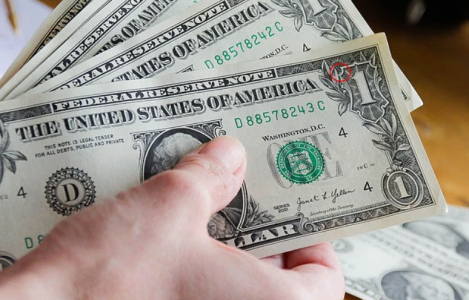You’ve probably missed this small detail on every dollar bill
- Replies 0
Take a dollar bill out of your wallet and hold it up to the light. Focus on the top right corner on the front—just above the large number "1."
You’ll notice a tiny, dark shape carefully embedded within the intricate and detailed scrollwork of the design.
It’s surprisingly easy to overlook at first glance, but once you finally spot it, you’ll find yourself wondering how such a curious detail ever managed to escape your attention before.
Some say the shape looks like a spider with legs ready to scurry off the page, while others insist it’s an owl sitting alert and watching.
The debate around this minuscule mark has sparked endless speculation for decades. Some view it as a symbol of wisdom or secret knowledge, while others see it as a harmless artistic flourish. Regardless of what you see, its true purpose has never been officially confirmed.
The US Treasury has never commented on the mark’s origin or meaning, and no known document explains why it appears on every $1 bill.
Currency historians point to the 1920s, when the design was finalized, but no engraver has come forward to claim responsibility for the symbol.

“The unknown engraver who designed the dollar bill took the secret, if there is one, to his grave,” said Ralph Benko, chairman of The Capitalist League. “I fancy it as a tiny owl.”
What makes this shape so fascinating is that it’s not a printing mistake or damage—it's part of the official design and appears in the same spot on every single note.
Experts believe it’s a unique flourish within the guilloche, the swirling anti-counterfeiting pattern found throughout the bill.
Still, this particular shape stands out from the rest, partially enclosed and clearly different in form and detail. That small inconsistency is what keeps observers intrigued and guessing.
Many people see meaning in the mark because of a psychological phenomenon called pareidolia. This is the brain’s tendency to interpret vague images as familiar objects, especially faces or creatures.
It's the same reason people see shapes in clouds, faces in tree bark, or religious figures in food. Our survival instincts make us hyper-aware of patterns, even when none were intentionally placed.
The $1 bill already contains multiple symbols that have fueled conspiracy theories for generations. The pyramid and all-seeing eye on the reverse side are often cited as evidence of Freemason or Illuminati influence.
This has made the unknown figure above the “1” a natural addition to that web of speculation. But despite endless online discussions, there is no historical record tying the shape to any known secret society.
Reddit users and YouTubers have offered dozens of theories, ranging from the silly to the surreal. Some believe the mark is “Moloch, the owl god worshipped at Bohemian Grove.”
Others joke it’s “Jesus Christ watching you throw it at somebody’s daughter,” or a “baby kraken.” The shape has also been called a miniature chupacabra, Mothman, and even a spider that “spun the webs.”
Despite the jokes and speculation, the $1 bill’s design is legally protected and has remained unchanged since the 1920s.
That means the tiny mark has quietly passed through millions of hands for nearly a century. It’s neither an accident nor random ink—its consistent placement confirms it was an intentional part of the original engraving.
But the lack of documentation ensures it will remain an open question. People are fascinated not because they know the answer, but because they don’t—and maybe never will.
In a time where almost anything can be explained or debunked, this tiny detail offers a rare kind of mystery. It's a reminder that not everything in plain sight has to come with an explanation. Sometimes, the questions are more compelling than the answers.
Read next:

Have you ever noticed the tiny mark above the “1” on your dollar bill? Do you think it’s a spider, an owl, or something else entirely? What’s your theory about where it came from and why it’s there? Drop your thoughts in the comments and share this article to keep the mystery alive.
You’ll notice a tiny, dark shape carefully embedded within the intricate and detailed scrollwork of the design.
It’s surprisingly easy to overlook at first glance, but once you finally spot it, you’ll find yourself wondering how such a curious detail ever managed to escape your attention before.
Some say the shape looks like a spider with legs ready to scurry off the page, while others insist it’s an owl sitting alert and watching.
The debate around this minuscule mark has sparked endless speculation for decades. Some view it as a symbol of wisdom or secret knowledge, while others see it as a harmless artistic flourish. Regardless of what you see, its true purpose has never been officially confirmed.
The US Treasury has never commented on the mark’s origin or meaning, and no known document explains why it appears on every $1 bill.
Currency historians point to the 1920s, when the design was finalized, but no engraver has come forward to claim responsibility for the symbol.

You’ve probably missed this small detail on every dollar bill. Image source: Getty Images / DailyMail
“The unknown engraver who designed the dollar bill took the secret, if there is one, to his grave,” said Ralph Benko, chairman of The Capitalist League. “I fancy it as a tiny owl.”
What makes this shape so fascinating is that it’s not a printing mistake or damage—it's part of the official design and appears in the same spot on every single note.
Experts believe it’s a unique flourish within the guilloche, the swirling anti-counterfeiting pattern found throughout the bill.
Still, this particular shape stands out from the rest, partially enclosed and clearly different in form and detail. That small inconsistency is what keeps observers intrigued and guessing.
Many people see meaning in the mark because of a psychological phenomenon called pareidolia. This is the brain’s tendency to interpret vague images as familiar objects, especially faces or creatures.
It's the same reason people see shapes in clouds, faces in tree bark, or religious figures in food. Our survival instincts make us hyper-aware of patterns, even when none were intentionally placed.
The $1 bill already contains multiple symbols that have fueled conspiracy theories for generations. The pyramid and all-seeing eye on the reverse side are often cited as evidence of Freemason or Illuminati influence.
This has made the unknown figure above the “1” a natural addition to that web of speculation. But despite endless online discussions, there is no historical record tying the shape to any known secret society.
Reddit users and YouTubers have offered dozens of theories, ranging from the silly to the surreal. Some believe the mark is “Moloch, the owl god worshipped at Bohemian Grove.”
Others joke it’s “Jesus Christ watching you throw it at somebody’s daughter,” or a “baby kraken.” The shape has also been called a miniature chupacabra, Mothman, and even a spider that “spun the webs.”
Despite the jokes and speculation, the $1 bill’s design is legally protected and has remained unchanged since the 1920s.
That means the tiny mark has quietly passed through millions of hands for nearly a century. It’s neither an accident nor random ink—its consistent placement confirms it was an intentional part of the original engraving.
But the lack of documentation ensures it will remain an open question. People are fascinated not because they know the answer, but because they don’t—and maybe never will.
In a time where almost anything can be explained or debunked, this tiny detail offers a rare kind of mystery. It's a reminder that not everything in plain sight has to come with an explanation. Sometimes, the questions are more compelling than the answers.
Read next:
- Be informed: How a global currency shift could impact the dollar and your finances
- Discover why the dollar bill is vanishing in these countries–and how it affects your money's future!
Key Takeaways
- There is a small, unconfirmed symbol located above the large “1” on the front of every U.S. $1 bill, often interpreted as either an owl or spider.
- The US Treasury has never acknowledged or explained the symbol, and no engraver has claimed responsibility for it.
- Experts suggest it’s likely part of the guilloche pattern used to prevent counterfeiting, though this specific detail is distinct in appearance.
- The $1 bill's design, including this symbol, has remained unchanged since the 1920s and is legally protected from alteration.






